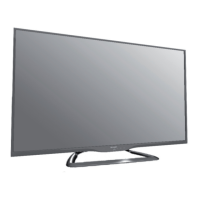
Do you have a question about the Sharp LC-60LE651 MK2 and is the answer not in the manual?
General safety warnings for service technicians and circuit modifications.
Safety checks for fire and shock hazards before returning the receiver to the user.
Notice regarding safety characteristics of parts and use of identical replacement parts.
Explanation of the LF symbol indicating lead-free solder and its types.
Guidance on using lead-free wire solder for repairs to prevent damage.
Advice on soldering techniques and precautions for lead-free solder.
Information on proper disposal of used equipment for private users in the EU and globally.
Information on proper disposal of used equipment for business users.
Cursor, OK, Menu, Back, Exit, and Color buttons for navigation and command execution.
Buttons for NET, Sound Mode, Picture Format, ECO, Teletext, and Subtitle functions.
Buttons for Volume, Mute, Source selection, Media playback, and USB recording.
Buttons for ATV/DTV mode, Picture Adjustment, 3D viewing, and Standby/On.
Diagram and labels for the TV's front view controls.
Important warnings regarding sound pressure from earphones/headphones.
Diagram and labels for the TV's side and rear view ports.
Step-by-step guide for inserting batteries into the remote control.
Precautions for using the remote control to prevent damage or malfunction.
Steps for connecting cables and preparing the TV for initial setup.
Instructions on powering on the TV and initiating the auto-installation process.
Confirmation of setup completion and connecting external devices.
Important notes and precautions before making external device connections.
Overview of the TV's terminals and guidance on connecting devices.
Lists common TV problems and their possible solutions.
Information about software components and copyrights used in the product.
Instructions for setting up the TV's network connection.
Detailed steps for setting up a wired LAN connection.
Detailed steps for setting up a wireless LAN connection.
Instructions for connecting to a wireless network using the USB adapter.
Notes regarding network setup, access points, and bandwidth requirements.
Overview of TV menu options related to AQUOS NET+ access.
Explanation of the basic operation of the AQUOS NET+ screen.
Details on navigating and selecting services within AQUOS NET+.
How to select services and use the search utility within AQUOS NET+.
Describes the functional areas of the Home Screen.
Explains advanced operations like search results and keyboard mapping.
Provides an overview of user-defined favorite applications.
Essential checks before powering on the TV for initial setup.
Steps for setting menu language, energy efficiency, and TV location.
Selecting broadcast settings, languages, and tuner configurations.
Specific settings required for DVB-T reception.
Choosing the network for DVB-C channel reception.
Specifying whether to search for coded stations.
Selecting the method for searching TV stations.
Defining start frequency and network ID for channel search.
Deciding whether to accept logical channel numbers for sorting.
Settings for receiving a single satellite via LNC.
Settings for multiple satellites using switchboxes or DiSEqC.
Settings for DiSEqC single cable systems and other communal installations.
Choosing the network for DVB-S channel reception.
General settings applicable to every satellite received.
Specifying coded station search and search methods.
Setting symbol rate and deciding on logical channel number acceptance.
Restricting programs by age classification and setting time/date.
Configuring network settings for internet connection.
Steps to select Setup, Stations, and Manual Scan TV.
Aligning antenna for max signal and initiating station search.
Steps for removing stand, rear cabinet, and disconnecting connectors.
Instructions for detaching power unit, main unit, and speakers.
Instructions for removing chassis bracket and control button holder.
Instructions for detaching the key unit and pyramid lighting diffuser.
Instructions for detaching the LCD module and control unit.
Procedure for adjusting performance after PWB or IC replacement.
Standard methods for entering and exiting service adjustment mode.
Key operations within the service mode for adjustment.
Explanation of the main service adjustment menu display.
Displays system information and GUI-related settings.
Options related to exceptions and chassis configurations.
Settings for MPEG deblocking, deringing, and audio delay.
Settings for auto power-off and wide screen signaling evaluation.
Settings for old software versions and panel features (200Hz, 3D, flip).
Settings for RC5 mapping, subsystem, and general service options.
Selecting the source for system time information.
Settings for warmup mode and managing the station list.
DVB information, Common Interface settings, and chassis options.
EPG settings, including reset update date and clearing the database.
Picture Quality settings and Public Mode configuration.
Configuring volume limits, RC, panel, and menu button behavior.
Settings for on-screen display and default input mode.
Setting the default program number for TV input mode.
Fixing input mode and configuring RC path through.
Hotel mode activation and RS232/HDMI power on settings.
Commands to confirm, reset, or cancel changes.
Settings for white balance adjustment, including MGAMMA reset.
Settings for MGAMMA patterns (IN1-IN6) for adjustment.
MGAMMA IN R1 and G1 settings for color temperature adjustment.
MGAMMA IN B1-B6 settings for color temperature adjustment.
Factory initialization command and screen size setting.
Information and reset function for operation hours.
Commands to erase NVM and set the auto installation flag.
Activates LCD controller test patterns for diagnostics.
SmartLoader function and hardware adjustment execution.
Sections for noise level and teletext information marked as 'Don't use'.
Setting the TV location by selecting the country.
Specifies conditions, reference device, and target values for adjustment.
Steps to navigate the White Balance and GAMMA menus.
Steps to reset MGAMMA values and restore defaults.
Detailed steps for adjusting MGAMMA patterns R1-R6 and B1-B6.
Steps to commit and save the new white balance values.
Steps to enter service mode and initialize factory settings.
Lists settings that revert to factory defaults after reset.
Steps to activate VCOM pattern and set initial value.
Adjusting VCOM values to minimize flicker and hide pattern.
Methods to enter and display the Public Mode settings screen.
Detailed settings available in Public Mode for TV operation.
Settings for input mode, hotel mode, and program number.
Settings for RC path through and RS232/HDMI power on requiring hardware.
Committing changes, resetting settings, and accessing the Public Mode menu.
Explanation of the Smartloader function for replicating TV settings.
Detailed steps for saving and loading settings using Smartloader.
Details on RS-232 terminal software configuration.
Procedure to check the RS-232 connection with the TV.
Steps to enter and exit the special 'K MODE' for service adjustments.
Procedure to change model and adjust VCOM in K MODE.
Instructions for updating TV software using a USB drive.
Instructions for updating TV software directly from the internet.
Important notes and precautions during software updating.
Details on main unit ICs like HDMI Switch and Audio Amplifier.
Description of headphone amplifier and USB hub controller ICs.
Details of the 2Gb 16Bits DDR3-1600 SDRAM ICs.
Description of USB load switch and low dropout LDO ICs.
Description of the SOC IC (ST MICRO FLI7560-AAB).
Description of the standby controller IC (ST MICRO STM8S105K4T6CTR).
Description of the 2Gbit NAND FLASH IC (MICRON MT29F4G08ABADAWP).
Description of the 10/100 Fast Ethernet Transceiver IC (MICREL KSZ8081RND).
Details on features like auto-negotiation and loopback modes.
Description of the Silicon Tuner IC (SILICON LABS Si2178).
Details on tuner IC features like reception performance and power consumption.
Description of the DVB-T/C Demodulator IC (SILICON LABS Si2165).
Details on demodulator IC features like bandwidth, ADCs, and AGC controls.
Description of the DVB-T/C/S/S2 Demodulator IC (SILICON LABS Si2167).
Features for DVB-T, DVB-C, DVB-S2, and DVB-S standards support.
Description of the DVB-T/C/T2 Demodulator IC (SILICON LABS Si2168).
Features for DVB-T2, DVB-T, and DVB-C standards support.
Description of the LNB supply and control IC (ST MICRO LNBH23).
Information about the 8-Bit Flash Microcontroller IC (Microchip PIC16LF1503T).
Details on RISC CPU, oscillator structure, and microcontroller features.
Description of ADC, Comparators, Voltage Reference, and Timers.
Features related to microcontroller software control and NCO.
Details on selectable output modes and Complementary Waveform Generator.
General description, voltage measurement conditions, and resistor/capacitor indications.
Indications for resistors and capacitors used in schematic diagrams.
Caution regarding potential slight differences in schematic diagrams.
Printed wiring board layout for the main unit, side A.
Chip placement diagram for the main unit PWB, side A.
Chip placement diagram for the main unit PWB, side B.
Chip placement diagram for the main unit PWB, side B.
Power Unit PWB layout diagram, side A.
Power Unit PWB layout diagram, side B.
Control Unit PWB layout diagram, side A.
Control Unit PWB layout diagram, side B.
Key Unit PWB layout diagram, side A.
Key Unit PWB layout diagram, side B.
Note that parts are supplied as assemblies, not independently.
List of replacement parts for the LCD panel.
List of replacement printed wiring boards.
List of replacement integrated circuits.
Lists of replacement transistors, diodes, and packaged circuits.
List of replacement coils and filters.
List of replacement capacitors.
List of replacement resistors.
List of miscellaneous replacement parts including tuners and transformers.
Specific parts list for LC-60LE651/LC-60LE652 models.
Replacement parts for the power unit and accessory items.
List of parts related to packing the set.
Diagram showing the location of mechanical parts for disassembly.
Detailed list of cabinet and mechanical parts with part numbers.
Diagram illustrating how to pack the 60" TV set.




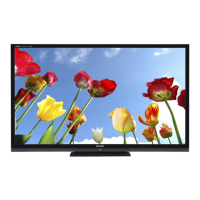


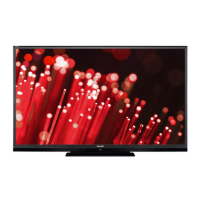
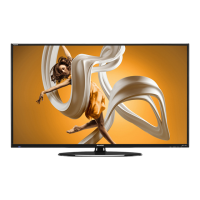


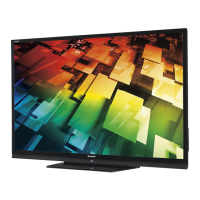
